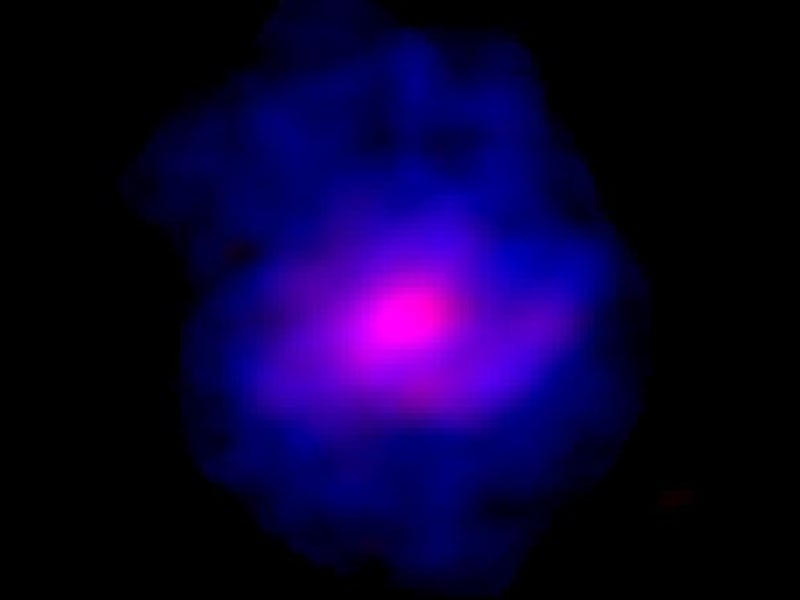This baby galaxy debunks a long-held theory about the universe
ALESS 073.1 looks a little old for its age.

Galaxies are all-encompassing creatures of the universe. They contain masses of gas, dust, black holes, stars, and all the myriad worlds in orbit around those fiery orbs. It takes a lot of time for a galaxy to truly blossom into a fully developed celestial being, like our own 13.5-billion-year-old Milky Way.
But a recent discovery of a young galaxy defies what scientists thought they knew about galaxy formation, suggesting we need to rethink exactly how these cosmic beings evolve. Essentially, like a teenager trying to use their older brother's I.D. to talk their way into the club, this juvenile galaxy appears to be far more mature than its true age.
Despite being observed just 1.2 billion years after the Big Bang, the galaxy already had a massive bulge, a regular rotating disk, and even signs of spiral arms. These features typically develop within galaxies over much longer periods of time — and certainly not within 1 billion years of being formed.
"This galaxy looks like a grown adult, but it should be just a little child."
The discovery is detailed in a study published Thursday in the journal Science.
By peering far into the universe, scientists discovered this odd galaxy that appeared far more mature than its age.
HOW THEY DID IT — Using the Atacama Large Millimeter/Submillimeter Array (ALMA) telescope, the scientists behind the recent discovery captured the sharpest images of a primordial galaxy ever produced.
The galaxy is dubbed ALESS 073.1, and the images show it at a time when the universe was a mere 1.2 billion years old (for context, scientists estimate the age of the universe to be about 13.8 billion years).
The galaxy is located 12.6 billion light-years away from Earth. The time that it took for the light from ALESS 073.1 to reach Earth allows the scientists to peer back at when the galaxy was a true galactic baby.
Gas motion in the distant galaxy ALESS 073.1: gas in blue is moving towards us while gas in red is moving away from us, indicating a rotating disk.
WHAT'S NEW — As they marveled at the young galaxy, the scientists were shocked to discover it had the features of a much older, more developed galaxy.
"We discovered that a massive bulge, a regular rotating disk, and possibly spiral arms were already in place in this galaxy when the universe was just 10 percent of its current age," Federico Lelli, a researcher at Cardiff University's School of Physics and Astronomy and lead author of the new study, said in a statement.
"In other words, this galaxy looks like a grown adult, but it should be just a little child."
The so-called 'bulge' is actually a tightly packed group of stars located at the center of the galaxy. Previously, scientists thought galaxies developed this bulge very slowly over time, through the merger of smaller galaxies or via other processes which occur within galaxies.
Also, ALESS 073.1 has spiral arms, similar to the ones observed on the Milky Way.
Our galaxy, the Milky Way, has spiral arms feature that extend from its center.
The arms extend from the galaxy's center, forming a circular, spiraling shape, and are made up of streams of stars. But spiral arms are also considered an indication a galaxy has left its younger, more chaotic years behind. The ordering of stars into distinct patterns is considered a sign that early, turbulent youth is behind a galaxy, and that the order of things is more settled.
WHAT'S NEXT — Galaxies like ALESS 073.1 defy scientists' current understanding of galaxy formation, and that poses deeper questions around how much we truly know about these cosmic beings. Ultimately, these findings call into doubt fundamental assumptions about the universe and, more locally, how our own galaxy may have evolved.
Primordial galaxies are a rarity — peering back in time to look at their distinct features and development is inherently difficult to do without the use of ever-greater telescopes, both in space and on Earth. By surveying the sky to seek them out and study them in detail, scientists could reveal more surprising — and more shocking — features, just like the ones discovered on ALESS 073.1.
Abstract: Cosmological models predict that galaxies forming in the early Universe experience a chaotic phase of gas accretion and star formation, followed by gas ejection due to feedback processes. Galaxy bulges may assemble later via mergers or internal evolution. Here we present submillimeter observations (with spatial resolution of 700 parsecs) of ALESS 073.1, a starburst galaxy at redshift z ≃ 5 when the Universe was 1.2 billion years old. This galaxy’s cold gas forms a regularly rotating disk with negligible noncircular motions. The galaxy rotation curve requires the presence of a central bulge in addition to a star-forming disk. We conclude that massive bulges and regularly rotating disks can form more rapidly in the early Universe than predicted by models of galaxy formation.
This article was originally published on